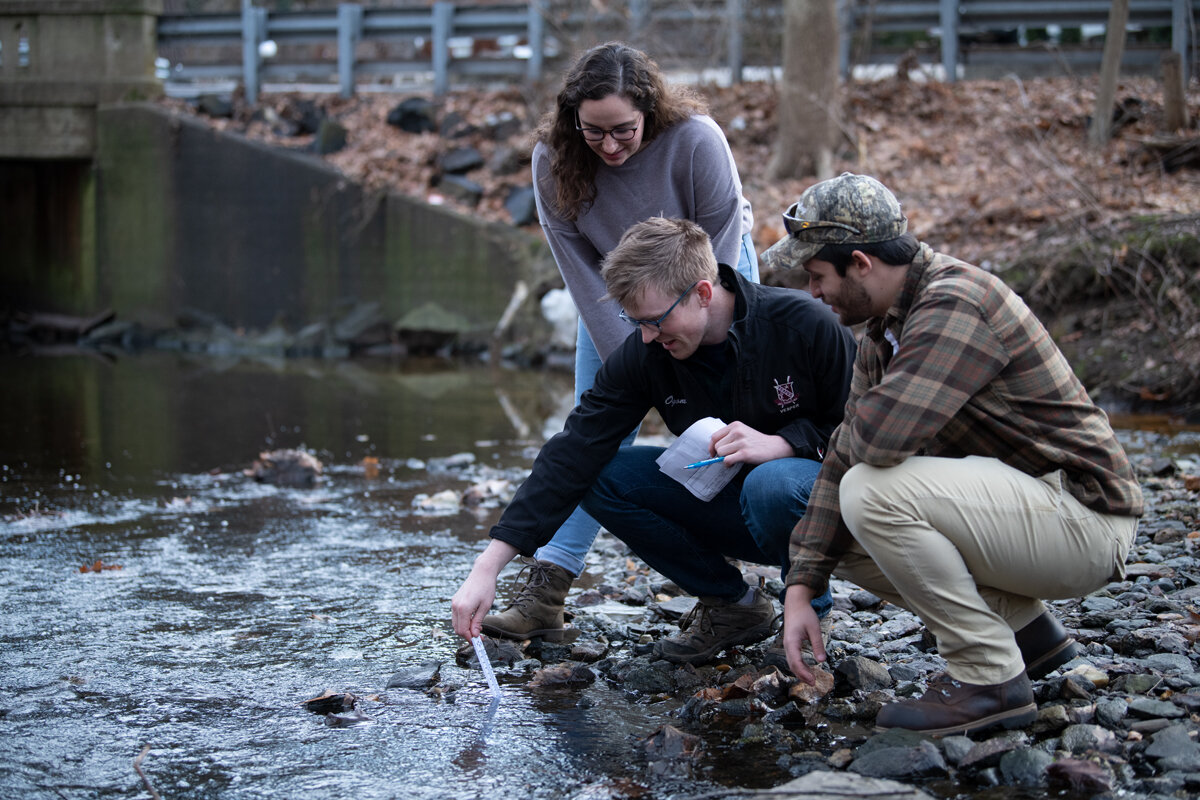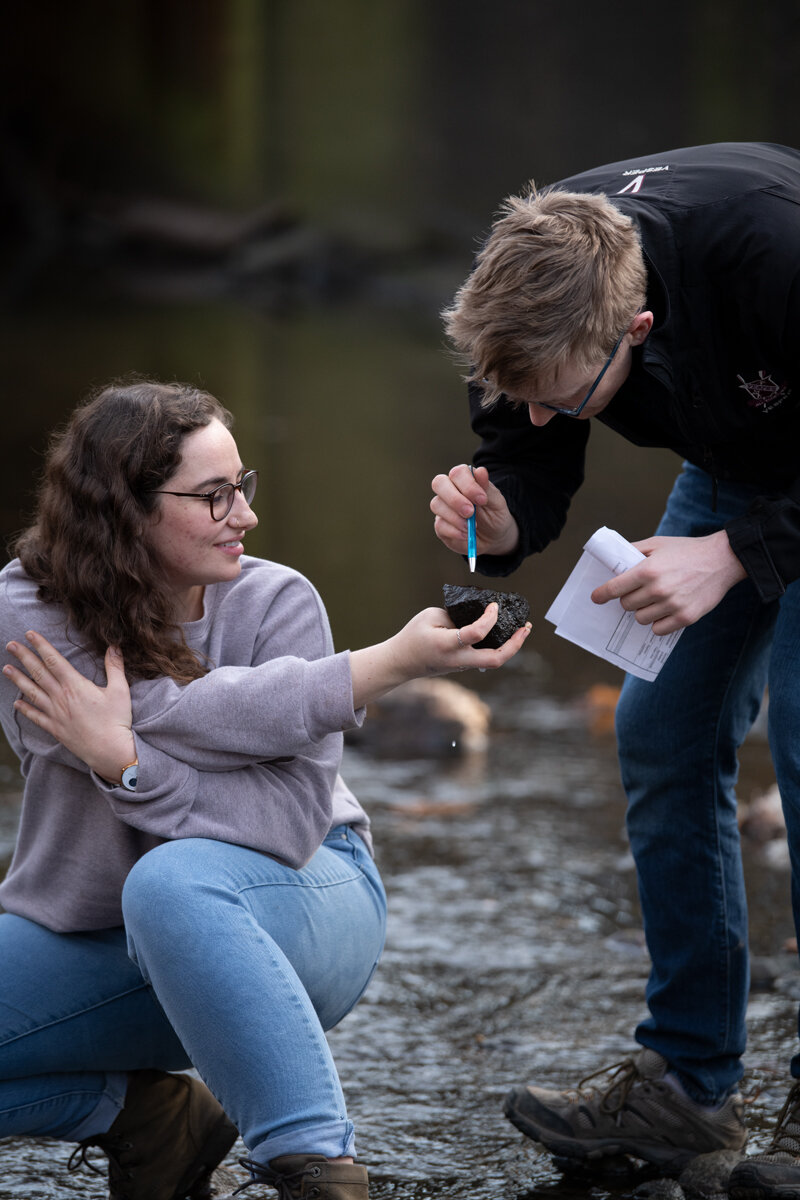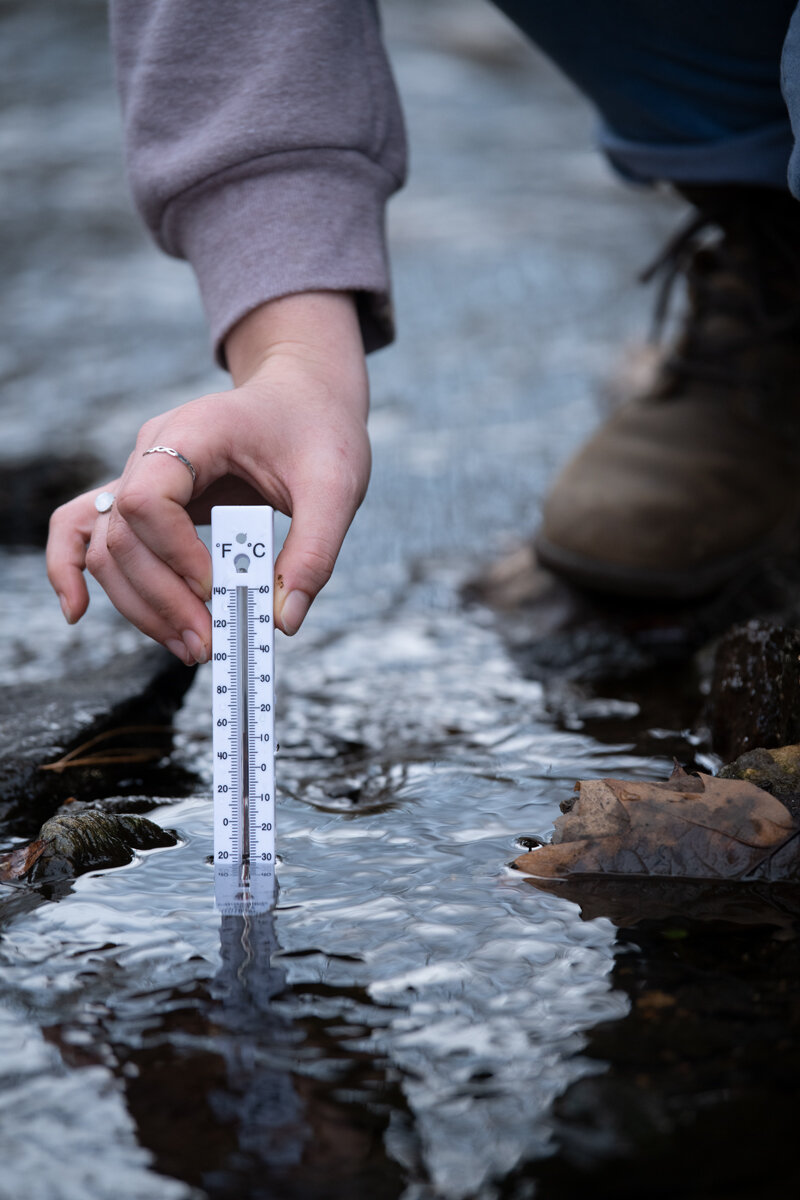Photography by Linette Kielinski
By Meredith Jones
On a balmy 60-degree morning in early January, three people convene at Coventry Park, a swath of green space in Elkins Park, for their monthly observation of the Tookany Creek. Volunteers Marika Zeldenrust and Pete Ogonek meet Ryan Neuman, who serves as the the upstream conservation leader for the Tookany/Tacony-Frankford Watershed (TTF) Partnership. Zeldenrust and Ogonek exude excitement, which is noteworthy given that it’s 8 a.m. on a Saturday morning. After recording data about the stream, they will go to a tree planting event at the nearby Pennypack Park.
Streamkeepers are the eyes and ears of local waterways. They document all of the impacts of stormwater and pollution, and provide an ongoing reference point for current and future protectors of our watersheds. The forms they fill out during each visit log the state of water clarity, surface coating, odor, stream bed color, percentage of tree canopy, algae cover, erosion, aquatic vegetation and water temperature.
Zeldenrust and Ogonek scramble over slippery moss-covered rocks and around the branchy banks of the creek to harvest the abundance of plastic bags, water bottles and snack wrappers. As they fill trash bags, we chat about the work that they do as Streamkeeper volunteers. Ogonek tells me, “I have done a lot of outreach, water education and water-security-based studies in school, so I wanted to get involved here because I saw a lot of parallels to that.
Zeldenrust and Ogonek met at Drexel University, and both focused their studies on environmental issues. Zeldenrust works for Environmental Resources Management, a consulting firm focused on regulatory compliance and design for stormwater management, as well as water quality modeling and sampling. Ogonek is employed by engineering and consulting firm NV5 as a water resources engineer. He was drawn to his volunteer work because of an alliance between the TTF and his employer, and soon invited his college buddy to join him.
“Pete mentioned that his company was a corporate sponsor for TTF and that he had heard about the Streamkeeper program, and asked if I was interested,” Zeldenrust says. “I think citizen science is really valuable and wanted to get involved, so we decided to share a site and do the monitoring together. We’ve enjoyed it a lot so far.”
But it isn’t just sustainability professionals who help out. According to Neuman, many volunteers are people who live in the neighborhoods of the streams and seek a more meaningful way to interact with the natural space around them. Some have been performing these monthly visits since the program’s inception in 2015. Neuman says that this dedication to years of early morning data collection reflects the tremendous amount of pride volunteers feel in the work that they do.
Photography by Linette Kielinski
Part of a Bigger Effort
If you follow the twisting path of Tookany Creek, it becomes Tacony Creek, transforming into Franklin, which ultimately flows into the Delaware River, bringing with it the pollutants that have been picked up as it runs through the communities along the way. This is where TTF and the Streamkeepers come into play, to stop the flow of contamination before it can make its way downstream.
TTF is part of the Upstream Suburban Philadelphia Collaborative, which encompasses 193 square miles stretching through portions of Bucks, Delaware and Montgomery counties that feed into the
Delaware River Watershed. These waterways are monitored and maintained by more than 150 steamkeeper volunteers.
Every member organization within the Upstream Philadelphia Suburban Philadelphia Collaborative is tasked with protecting and restoring these sources of our drinking water. Their challenges are significant, driven in large part by ever-increasing development in the communities surrounding these watersheds. Concrete is an enemy to clean water, specifically because it creates stormwater runoff.
The term stormwater runoff simply refers to any rain water which is not absorbed into the ground, and as a result ends up rushing into either our storm drains, rivers or streams.
Stormwater can cause basements and roadways to flood, but the less visible impacts are often the more insidious. Rushing over our yards, sidewalks and roads, these waters collect and carry herbicides, pesticides, leaked car oil, the residue of salt and brine from roadways, and in the most severe cases, overflow from sewers. This toxic cocktail, delivered at torrential speed into our rivers and streams, is a death sentence for many species of wildlife and vegetation that call these waters home.
The more a given area is covered by pavement, roofs and treeless lawns, the more the problem of overflow is exacerbated. The City of Philadelphia Water Department estimates that the breakdown of stormwater in an urban environment amounts to 30 percent evaporation and 15 percent infiltration into the ground, leaving a whopping 55 percent gushing as runoff. By comparison, in a natural environment they estimate a spread of 40 percent evaporation, 50 percent ground infiltration, and only 10 percent runoff.
Photography by Linette Kielinski
The streamkeepers round out their first-hand documenting experience by attending monthly workshops organized by the conservation groups within the cluster. Past workshops have included a walking tour of Haverford Township rain garden sites, a presentation of how to convert a turf lawn into a rainwater-thirsty meadow, identifying environmentally harmful construction sites and habitat assessments. In 2020, additional educational opportunities will include a tour of an area wastewater treatment plant, macroinvertebrate training, workshops on algae monitoring and invasive species identification. These workshops are a collective effort through the collaboration of the Wissahickon Valley Watershed Association, Lower Merion Conservancy, Friends of the Poquessing Watershed, Darby Creek Valley Association and Pennypack Ecological Restoration Trust.
In addition to recording the baseline data to monitor headwaters and implementing community outreach, TTF coordinates a variety of conservation projects throughout the year. Ongoing initiatives encompass storm drain marking, creating rain gardens in parks surrounding the creek, installing creekside buffers, litter removal days and freshwater mussel surveying.
Although these events are open to the public, Streamkeepers frequently make up a majority of the volunteers. To date, they have been part of efforts that created more than 60,000 square feet of stream buffer area that will serve to filter and slow runoff water before it hits the stream, while the native plants will provide much needed wildlife nourishment and habitat. The sites of TTF projects have gained recognition from the Pennsylvania Horticultural Society, Audubon Society and National Wildlife Federation.
The Streamkeeper program is not only cultivating citizen scientists, but also citizen advocates.
Photography by Linette Kielinski
Lindsay Blanton, water programs manager at the Wissahickon Valley Watershed Association, recalls a number of instances in which volunteers have been able to make an impact.
“One volunteer was observing a site with a railway bridge over it. The rails are periodically treated with a chemical spray, which in this instance had been oversprayed and was visibly dripping in large amounts into the stream beneath it,” she says.
On another occasion, a streamkeeper was caught unexpectedly in a thunderstorm, and in the rapidly rising water she witnessed at least 20 dead fish being carried by the stream. Another volunteer came upon a construction site operating outside the regulatory framework of stormwater management. Each of these instances were reported to the Pennsylvania Department of Environmental Protection, and in the cases of the fishkill and construction site violations, there were fines levied against the offending corporations.
TTF Executive Director Julie Slavet praises the dedication of the volunteers.
“The most inspiring qualities demonstrated by our Streamkeepers are their thirst for knowledge of watershed issues, and their willingness to serve as ambassadors by sharing this newfound knowledge with neighbors or elected officials though conversations, at community meetings or lobbying days on the hill, or writing letters to the editor,” she says.
Neuman echoes the impact of these learning sessions: “So many of our volunteers get excited to take something that they learned in a workshop, and tell their neighbors about it, whether it’s about how to wash their car or take care of their lawn without a lot of chemical overuse, or just pointing out, ‘Hey, these storm drains dump directly into that stream down the street. Let’s be careful what goes down them.’”













